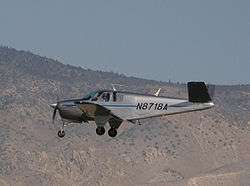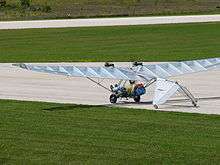V-tail



In aircraft, a V-tail or Vee-tail (sometimes called a Butterfly tail[1]) is an unconventional arrangement of the tail control surfaces that replaces the traditional fin and horizontal surfaces with two surfaces set in a V-shaped configuration when viewed from the front or rear of the aircraft. The aft edge of each twin surface is a hinged control surface (sometimes called a ruddervator) which combines the functions of both elevators and rudder.
Variants
The V-tail, invented and patented in 1930 by Polish engineer Jerzy Rudlicki, has not been a popular choice for aircraft manufacturers.
The X-shaped tail surfaces of the experimental Lockheed XFV were essentially a V tail that extended both above and below the fuselage.
Conventional
The most popular conventionally V-tailed aircraft that was mass-produced is the Beechcraft Bonanza Model 35, often known as the V-tail Bonanza or simply V-Tail. Other examples include the F-117 Nighthawk stealth fighter and the Fouga Magister trainer.
Inverted
The Blohm & Voss P.213 Miniaturjäger was one of the first aircraft having an inverted v-tail. Unmanned aerial vehicles such as the Amber, GNAT and the MQ-1 Predator would later feature this type of tail.[2] The Ultraflight Lazair ultralights, of which over 2000 were produced, also featured an inverted V-tail.[3]
Advantages
Ideally, with fewer surfaces than a conventional three-aerofoil tail or a T-tail, the V-tail is lighter, has less wetted surface area, so thus produces less induced and parasitic drag. However, NACA studies indicated that the V-tail surfaces must be larger than simple projection into the vertical & horizontal planes would suggest, such that total wetted area is roughly constant; reduction of intersection surfaces from three to two does, however, produce a net reduction in drag through elimination of some interference drag.[4]
In modern day, light jet general aviation aircraft such as the Cirrus Vision, Eclipse 400 or the unmanned aerial drone Global Hawk often have the power plant placed outside the aircraft to protect the passengers and make certification easier. In such cases V-tails are used to avoid placing the vertical stabilizer in the exhaust of the engine, which would disrupt the flow of the exhaust, reducing thrust and increasing wear on the stabilizer, possibly leading to damage over time.[5]
Disadvantages
In the mid-1980s, the Federal Aviation Administration grounded the Beechcraft Bonanza due to safety concerns. While the Bonanza met the initial certification requirements, it had a history of fatal mid-air breakups during extreme stress, at a rate exceeding the accepted norm. The type was deemed airworthy and restrictions removed after Beechcraft issued a structural modification as an Airworthiness Directive.[6]
Ruddervators
Ruddervators are the control surfaces on an airplane with a V-tail configuration. They are located at the trailing edge of each of the two airfoils making up the tail of the plane. The first use of ruddervators may have been on the Coandă-1910's X-tail, although there is no proof that the aircraft ever flew.[7] The later Coandă-1911 flew with ruddervators on its X-tail.[8] Later Polish engineer Jerzy Rudlicki designed the first practical ruddervators in 1930, tested on a modified Hanriot H-28 trainer in 1931.
The name is a portmanteau of the words rudder and elevator. In a conventional aircraft tail configuration, the rudder provides yaw (horizontal) control and the elevator provides pitch (vertical) control.
Ruddervators provide the same control effect as conventional control surfaces, but through a more complex control system that actuates the control surfaces in unison. Yaw moving the nose to the left is produced on an upright V tail by moving the pedals left which deflects the left-hand ruddervator down and left and the right-hand ruddervator up and left. The opposite produces yaw to the right. Pitch nose up is produced by moving the control column or stick back which deflects the left-hand ruddervator up and right and the right-hand ruddervator up and left. Pitch nose down is produced by moving the control column or stick forward which induces the opposite ruddervator movements.[9]
See also
References
- ↑ Barnard, R.H.; Philpott, D.R. (2010). "10. Aircraft control". Aircraft Flight (4th ed.). Harlow, England: Prentice Hall. p. 275. ISBN 978-0-273-73098-9.
- ↑ "Blohm & Voss BV P.213 Luft '46 entry". Luft46.com. Retrieved 2013-06-01.
- ↑ Hunt, Adam & Ruth Merkis-Hunt: Skeletal Remains, pages 64-70. Kitplanes Magazine, September 2000.
- ↑ Raymer, Daniel P. (1999). Aircraft Design: A Conceptual Approach (3rd ed.). Reston, Virginia: American Institute of Aeronautics and Astronautics. p. 78. ISBN 1-56347-281-3.
- ↑ "Cirrus SJ50 Design Notes". www.the-jet.com. Cirrus Design Corporation. 2008. Retrieved 2008-08-14.
- ↑ "FAA Airworthiness Directive 93-CE-37-AD as Amended". Federal Register:(Volume 68, Number 93)Docket No. 93-CE-37-AD; Amendment 39-13147; AD 94-20-04 R2. Federal Register. May 14, 2003. Retrieved 2008-08-14.
- ↑ "L'Aéronautique, Volume 17". L'Aéronautique (in French). 17: 333. 1935.
- ↑ Flight magazine (October 1911). "Flight 28 October 1911". Retrieved 11 January 2011.
- ↑ Eckalbar, John C. (1986). "Simple Aerodynamics Of The V-Tail". Retrieved 2008-08-13.
External links
| Wikimedia Commons has media related to examples of V-shaped tail aircraft. |
| Wikimedia Commons has media related to V-shaped tails. |